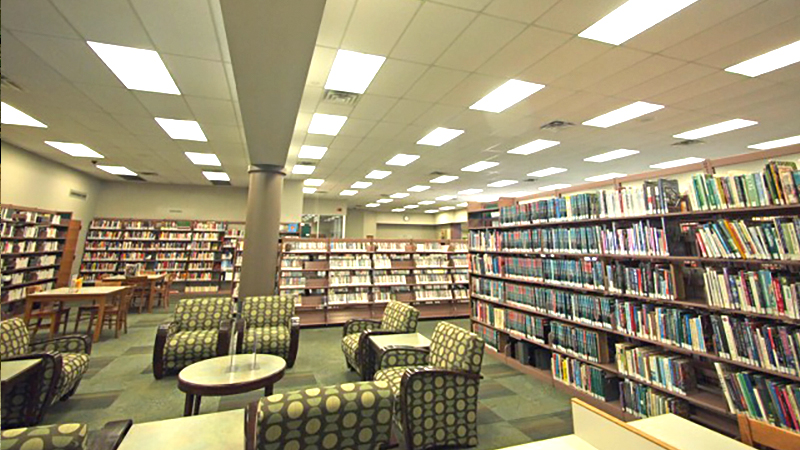Rogers Public Library
Rogers Public Library Director Judy Casey recalls meeting with fellow librarians at regional and state conferences, and hearing the same question: “‘Hey, Judy, are you still having problems with your HVAC system?’ It’s sad, but what they remembered about the Rogers Public Library was how uncomfortable it was.”
 Opened in 1993, the library experienced heating/cooling problems from day one. There were the usual issues facing all libraries, such as maintaining proper airflow in a room full of book-laden shelves that stand seven-and-half feet tall. Adding to the problem: an HVAC system that was wrong-sized for the 35,000 sq. ft. building, and poorly installed windows that let in excess moisture.
Opened in 1993, the library experienced heating/cooling problems from day one. There were the usual issues facing all libraries, such as maintaining proper airflow in a room full of book-laden shelves that stand seven-and-half feet tall. Adding to the problem: an HVAC system that was wrong-sized for the 35,000 sq. ft. building, and poorly installed windows that let in excess moisture.
“I’ve worked in and visited numerous libraries over my career, and my guess that is two-thirds of them have temperature and humidity problems,” Judy said. “Books do strange things to the air, and libraries are generally opened long hours, seven days a week, with patrons constantly opening and closing doors.”
The Rogers Public Library averages about 800 visitors a day, with that figure spiking to over a 1,000 in the summer months.
Judy said it wasn’t uncommon for summer temperatures inside the library’s main room to reach the 80s, while winter resulted in making some rooms “feel like you’re sitting in an icebox.”
“We were constantly being asked if the HVAC system was broken,” she said. “It was noticeably uncomfortable for both users of the library and the staff.”
Lighting was also an issue, with one patron suggesting the library put out donation jars to pay for upgrades. Most of the rooms were illuminated with metal halide pendant fixtures. Lower bookshelves were hidden in shadows while upper shelves were harshly lit.
Clear Energy was hired to correct the problems in the most cost-effective way. The work, conducted in two phases, included:
-
Clear Energy was hired to correct the problems in the most cost-effective way. The work, conducted in two phases, included:
- Converted the existing constant flow heating water distribution system to a variable flow distribution system. The constant flow system is inefficient as it constantly delivers the same amount of heating water based on peak conditions, which occur only during a small percentage of the time. The variable flow system responds to actual demand and, using variable speed pumps, delivers the heated water when needed.
- Replaced and converted constant volume air handling systems in two parts of the building to variable air volume systems (VAV). New VAV equipment was installed where needed, while some constant volume equipment was converted with variable speed motors.
- Replaced boiler and chiller units, as the equipment was inadequate for the task and nearing the end of its operational life. The new units are high-efficiency and sized correctly for the space.
- Implemented a strategy to bring in outside air for cooling without introducing excessive humidity into the building.
- Engineered, designed, and replaced overhead lighting with recessed direct/indirect fixtures and upgraded miscellaneous lighting for energy efficiency.
Difficult Working Environment
One of the first lessons a child learns when entering a library is to lower his or her voice and be quiet. The ubiquitous “Shhh! Please Be Quiet” signs graced most libraries in the 20th Century, only to be updated to “Please Turn Off Cell Phones” in the 21st Century.
For this reason and for patron safety, most of Clear Energy’s work took place after hours when the library was closed to the public.
“We really couldn’t close down, so anything in the public area had to be done after hours. It was a difficult working environment, but one in which Clear Energy worked to accommodate our needs,” Judy said.
“I Can See the Bottom Shelf”
Judy said the above comment was one of many voiced by library users after Clear Energy replaced the metal halide lighting. “It’s just so much more comfortable. The change was obvious and we’ve received nothing but compliments.”
Replacing the pendant lighting with recessed fixtures also lent a more open and spacious feel to the main room. The pendant lighting hung 30″ from the ceiling, creating an impression that the ceiling was lower. Once replaced, many visitors asked if the ceiling had actually been raised.
Mission Accomplished
Clear Energy’s HVAC work lowered energy consumption while eliminating the humidity problem and significantly improving temperature control. Replacing the outdated pendant metal halide lighting resulted in ambient lighting that was up to the task.
Project goals were improved comfort and functionality, but as with all Clear Energy retrofits, energy consumption was reduced and savings realized. Annual natural gas use was lowered almost 39% and electricity almost 36%.

